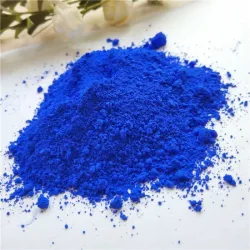Properties of Phthalocyanine Blue Pigment
2024-05-31
Phthalocyanine Blue is a widely used organic pigment known for its intense, vibrant blue color and excellent lightfastness. Here's an overview of Phthalocyanine Blue pigment, including its properties, applications, and considerations for use:
Properties of Phthalocyanine Blue Pigment
1. Color: Phthalocyanine Blue pigment exhibits a rich, deep blue color with high tinting strength and brilliance. It is known for its intense hue and excellent color purity.
2. Chemical Structure: Phthalocyanine Blue pigment belongs to the phthalocyanine class of organic pigments. Its chemical structure consists of a phthalocyanine ring system, which contributes to its stability and color properties.
3. Lightfastness: Phthalocyanine Blue pigment offers exceptional lightfastness, meaning it resists fading or color changes when exposed to light over time. This property makes it suitable for use in applications requiring long-term color stability, such as outdoor signage and fine art prints.
4. Opacity and Transparency: Depending on its specific formulation and particle size, Phthalocyanine Blue pigment can exhibit varying levels of opacity and transparency. It can be used to create both transparent glazes and opaque layers in painting and printing applications.
5. Chemical Stability: Phthalocyanine Blue pigment is chemically stable, resisting degradation from exposure to acids, alkalis, solvents, and environmental conditions. This stability ensures the longevity and durability of materials colored with this pigment.
6. Compatibility: Phthalocyanine Blue pigment is compatible with a wide range of binders, solvents, and additives used in various mediums, including oil and acrylic paints, printing inks, plastics, and coatings.
Applications of Phthalocyanine Blue Pigment
1. Paints and Coatings: Phthalocyanine Blue pigment is commonly used in the formulation of artist paints, industrial coatings, architectural paints, automotive coatings, and decorative finishes. It provides intense blue hues and excellent durability in both interior and exterior applications.
2. Printing Inks: Phthalocyanine Blue pigment is a key component of printing inks used in offset printing, gravure printing, flexographic printing, and screen printing. It is used to produce vibrant blue colors in packaging, publications, labels, and commercial printing applications.
3. Plastics and Polymers: Phthalocyanine Blue pigment is incorporated into plastics and polymers to impart blue coloration to a wide range of products, including consumer goods, automotive parts, packaging materials, and household appliances.
4. Textiles and Fibers: Phthalocyanine Blue pigment is used in textile printing and dyeing processes to color fabrics, yarns, and fibers. It provides excellent colorfastness and resistance to washing and fading, making it suitable for use in apparel, home textiles, and industrial textiles.
5. Fine Arts: Phthalocyanine Blue pigment is a popular choice among artists for its intense blue color and lightfastness. It is used in oil paints, acrylic paints, watercolors, and other artist mediums to create vivid blue hues in paintings, drawings, and mixed media artworks.
Considerations for Using Phthalocyanine Blue Pigment
1. Pigment Concentration: Adjust the concentration of Phthalocyanine Blue pigment to achieve the desired color intensity and opacity in your paint, ink, or coating formulations.
2. Mixing and Compatibility: Ensure proper mixing and dispersion of Phthalocyanine Blue pigment in your medium to avoid issues such as streaking, graininess, or poor color development.
3. Lightfastness Testing: Conduct lightfastness tests to evaluate the long-term color stability of materials colored with Phthalocyanine Blue pigment, especially for outdoor or high-exposure applications.
4. Health and Safety: Handle Phthalocyanine Blue pigment with care and follow safety guidelines regarding exposure, ventilation, and personal protective equipment. Some forms of Phthalocyanine Blue pigment may contain heavy metals or other hazardous components.
5. Regulatory Compliance: Ensure compliance with regulatory requirements and standards for the use of Phthalocyanine Blue pigment in specific applications, particularly in food contact materials, toys, and other consumer products.
6. Storage and Handling: Store Phthalocyanine Blue pigment in a cool, dry place away from direct sunlight and moisture to maintain its stability and color properties over time.
Conclusion
Phthalocyanine Blue pigment is valued for its intense blue color, excellent lightfastness, and versatility in various applications, including paints, inks, coatings, plastics, textiles, and fine arts. By understanding its properties, applications, and considerations for use, manufacturers, artists, and designers can effectively incorporate Phthalocyanine Blue pigment into their formulations to achieve vibrant blue colors with exceptional durability and color stability.



